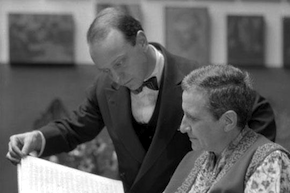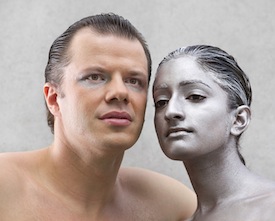
When SFMOMA decided to devote the summer to its exhibition “The Steins Collect: Matisse, Picasso, and the Parisian Avant-Garde,” its associate curator of public programs, Frank Smigiel, wasn’t satisfied with merely presenting Gertrude Stein as solely a collector of masterpieces. That wouldn’t do justice to the writer who changed 20th-century literature so dramatically.
The Contemporary Jewish Museum is also hosting Stein-related displays plus a gallery talk on Aug. 18. So Smigiel wanted to “complement what’s happening in the exhibitions themselves by reactivating the avant garde energy that both shows speak to,” he says. “Stein’s text can replug into that energy [and] make you listen and look in a new way.” But exhibiting only Stein’s writings might have had the same distancing enshrinement as displaying her art collection. As anyone who has seen her plays can attest, Stein’s words literally come alive onstage. “Something about the live-ness of it makes the work intelligible in a way that seeing it on the page cannot,” Smigiel explains.
But neither recordings of Stein’s readings nor a restaging of her plays could match the power and popular appeal of her popular breakthrough (concurrent with the publication of her memoir in disguise, The Autobiography of Alice B. Toklas): the 1934 opera Four Saints in Three Acts, with music by another American then living in Paris, Virgil Thomson.
Staging the opera would also achieve another of Smigiel’s goals: illuminating Stein’s creative context in a way an exhibition alone couldn’t. As currently portrayed in Woody Allen’s movie Midnight in Paris, Stein operated in an artistically fertile milieu teeming with creative artists — Picasso, Matisse, Cocteau, and many others — who drew inspiration from each other. “We wanted to rev up the whole sense of artists creating in communities,” he says, “breaking out of the studio model of laboring away on their individual visions. They were hanging out in salons, seeing each other create, and responding to it all the time.”
Hardly a conventional narrative, the opera is a joyful revel in American language and musical forms.
Next weekend, that vision takes shape at San Francisco’s Yerba Buena Center for the Arts Novellus Theater in SFMOMA’s “updated, multimedia-infused restaging,” called Four Saints in Three Acts: An Opera Installation. It features Bay Area–based contemporary chamber opera group Ensemble Parallèle, directed by Brian Staufenbiel and conducted by Nicole Paiement. Along with a rarely seen later version of Stein and Thomson’s opera, the performance includes a newly commissioned response to Stein’s words, set by composer Luciano Chessa, with contributions from New York video/performance artist Kalup Linzy. It’s a bold, innovative concept that honors both the original material and its creators’ adventurous spirit. Just as the original Four Saints “shocked Americans into new ways of seeing,” Smigiel notes, this dual production may inspire in today’s audiences new insights into a landmark of modernist art.
Art World Takes the Lead
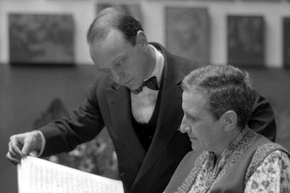
The art museum’s involvement in this new incarnation echoes the opera’s original production. Even though it was a work for music theater by a famous writer, “it was the art world that was interested in Four Saints,” Thomson (also a noted music critic) wrote, “not the music world or the theater world or the literary world.” That phenomenon was familiar to vanguard composers from Erik Satie to John Cage to Philip Glass, all of whom, and many others, initially found greater receptivity to their work in visual art spaces than in stodgy concert halls. The opera actually debuted in 1934, in America’s first public art museum, the Wadsworth Atheneum, in Hartford, Connecticut, moving to Broadway two weeks later. It received crucial support from the so-called “Harvard Modernists,” a rebellious young band of recent graduates (including Museum of Modern Art founder Alfred Barr, and modernist architect Philip Johnson) who were determined to create spaces for modernist art amid what had been drearily conservative artistic institutions.
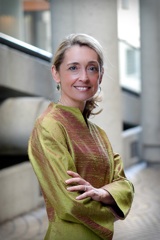
Stein’s text (as interpreted in a later-added scenario by Thomson’s partner, Maurice Grosser) involves a pair of 16th-century saints (Ignatius of Loyola and Teresa of Avila) recounting their lives and dancing a tango at a celestial lawn party. But Thomson and Grosser insisted that the scenario was by no means binding on Stein’s text or later productions. Even the title is unreliable; a significant part of Act 2 is devoted to an extended discussion of exactly how many saints are in the piece. Hardly a conventional narrative, the opera is more of a joyful revel in American language and musical forms, which its creators cherished.
“Please do not try to construe the words of this opera literally or to seek in it any abstruse symbolism,” Thomson said. “If, by means of the poet’s liberties with logic and the composer’s constant use of the simplest elements in our musical vernacular, something is here evoked of the childlike gaiety and mystical strength of lives devoted in common to a non-materialistic end, the authors will consider their message to have been communicated.”
To complement Stein’s playful but hermetic text, the 31-year-old Thomson decided to create a score whose superficial simplicity and grounding in American folk tunes would lure the most recondite musical conservatives. It was a conscious rejection of the then-fashionable European-inspired avant garde dissonance that Thomson thought passé. “For the most part, you didn’t know what it meant anyway, so you couldn’t make it like birdie babbling by a brook or heavy hangs my heart,” he said of Stein’s libretto. “You had to set it for the way the grammar went and for the clarity of the words. If you make the words clear for pronunciation, the meaning will take care of itself.” Her text “forced me to hear the sounds that the American language really makes when sung.”
“A Jew and a Protestant turn out a Catholic opera about Spain in the 16th century and in the course of writing that music, I came into practically total recall of my Southern Baptist upbringing in Missouri.” – Virgil Thomson
When Ensemble Parallèle Director Nicole Paiement first saw the score, she recalls that her initial reaction was: “My God, it’s so simple!” But now, “in studying it a lot, I realize its complexities” — unsettling harmonic language, quick shifts in tone and meter, and more. “My simplicity,” Thomson admitted, “was arrived at through the most elaborate means.”
“Beneath its apparently simple surface are finely calculated repetitions of musical phrases associated with syntactical units, bits of neo-Baroque recitative, and melodic lines that shift as the meter shifts,” Steven Watson wrote in his superb chronicle of the opera’s genesis, Prepare for Saints, to which this article is indebted. “Thomson drew on ... the patter of Anglican chant and the booming choruses of the Harvard Glee Club, marches and parlor dances, children’s games and Gilbert and Sullivan. Most of all he thought of American hymns. ‘When you reach down in your subconscious, you get certain things,’ observed Thomson. ... ‘When I reach down, I get southern hymns or all those dreadful ditties we used to sing. ...’” Thomson summed up Four Saints thus: “A Jew and a Protestant turn out a Catholic opera about Spain in the 16th century and in the course of writing that music, I came into practically total recall of my Southern Baptist upbringing in Missouri.”
Whether it was Thomson’s cheery, waltz-tinged score; Stein’s witty, similarly faux-simplistic language; the performances of the revolutionary all-black cast; rookie John Houseman’s direction; artist Florine Stettheimer’s striking sets (with cellophane backdrops) and her colorful taffeta, lace, and silk costumes; Frederick Ashton’s innovative choreography; Stein’s current popularity; or some compound of all the above — what Houseman called “that particular chemistry, that particular miracle” — Four Saints in Three Acts was perhaps the unlikeliest hit of all time. It became the longest-running opera in Broadway history, spawning a traveling production in Chicago, Stein’s subsequent sold-out lecture tour, and successful revivals by the likes of Robert Wilson and Mark Morris. “Its success epitomized the mainstreaming of modernism,” Watson wrote.
Treated as a Sacred Text
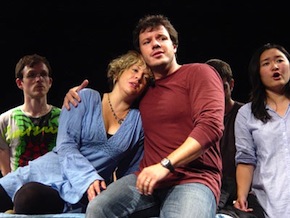
Photo by Michael Strickland
Years later, Thomson employed a reduced version of the opera for smaller orchestra, cutting some of Stein’s text and removed a few characters to whittle the performing time to under an hour. That’s the version, suitable to Ensemble Parallèle’s forces, used in this weekend’s production. The group was suggested by Berkeley-based composer Luciano Chessa, who had worked with it on an earlier project. He, in turn, had been chosen by Smigiel (who had collaborated with the Italian-born composer on a previous SFMOMA commission) to compose a new work to accompany the reduced Four Saints and also to conceivably stand on its own. A Heavenly Act will open the show. To maintain the close connection to Four Saints, Chessa chose to set all the text Thomson had cut from the original to make the short 1950s version. “I treated it as a sacred text,” he says, “and used all [Stein’s] words scrupulously.”
A scholar and admirer of the Italian “Art of Noise” composers of the 1920s, Chessa, who teaches at the San Francisco Conservatory of Music, might seem an unlikely pairing with the American-grounded Thomson. But, in fact, they shared common influences, including French composer Erik Satie and his younger acolytes known as Les Six. (Chessa notes that at one point, Satie wanted to use Art of Noise pioneer Luigi Rossolo’s noisemakers in his landmark ballet score Parade, but transportation proved too difficult. Chessa included a passage in A Heavenly Act that pays tribute to that ballet, for which Picasso designed the colorful backdrop.) Chessa also drew on favorite composers whom Thomson had influenced, including Robert Ashley, Julius Eastman, and Philip Glass.
Despite his interest in “noise music,” Chessa wanted music that was melodic and singable. “I’m interested in the friction between noise and melody,” he remarks. “Most of the language for this opera came from thinking about how Thomson worked with chant, something he started using when studying Stein’s words” in songs he set before commencing work on Four Saints. Chessa also drew on the venerable model of Claudio Monteverdi in finding different musical ways to convey meaning in text setting.
Chessa decided to respond to Thomson’s music by making a mirror image of his original score, “like a negative version as in a photograph.” He charted its different moods, its meters, and the like, and designed his music to contrast. He found Thomson’s first and last acts to be more “earthy” and the middle act more pastel and “heavenly.” That meant that Chessa’s outer acts would be more angelic, pale, heavenly — hence the title. “I have to thank Thomson for constructing an opera with clear curves, peaks, and valleys,” Chessa says.
Coming Down to Earth
That musical structure, in turn, suggested a dramatic arc. If the new opera’s action moved from heaven to earth and back to heaven (the opposite of Thomson’s scheme), that suggested a journey that’s the reverse of the typical literary path (for example, Dante’s Inferno) in which a protagonist moves from earth to heaven and back. And that journey, in turn, suggested a story line, which Stein’s words could be used to construct.
Like Thomson, Chessa found Stein’s text “very liberating because I’m guided not by meaning but in part by rhythm and sound, and above all algorithmically” in how she determined the frequency of repetition of some of the recurring terms. Unconstrained by their meaning, the composer felt free to move her words around, or assign them to different characters, to suit the new story line. “I was able to arrange her text to work with the story,” he explains. “I could not have done that with any other writer. It was a blessing. I was thanking her every day!”
The team followed Grosser (Thomson’s partner) in imposing a bit of a story — not a plot, exactly — on the scenario. As Paiement explains, “We came up with a general philosophical question: When is man playing God and when is he doing saintly actions?” Expect references to social issues such as the death penalty and assisted suicide — obliquely, of course. That led to this provocative story line, Chessa says: “What if an angel came down to earth and learned from us and returned to make a better heaven?”
“My simplicity,” composer Virgil Thomson admitted, “was arrived at through the most elaborate means.”
Themes of life, death, and justice emerge in the direction by Staufenbiel, who also uses elements of pantomime, as well as minimalist staging with an emphasis on white and primary colors. And the Brooklyn-based video and performance artist Linzy adds his peculiar projections (he’s often influenced by soap opera, if that’s any clue) to the proceedings. Internationally renowned soprano and Stanford faculty member Wendy Hillhouse, who’s sung with most of the major U.S. opera companies, takes the crucial role of the Commere in Four Saints, with former Chanticleer baritone John Bishoff as Compere. Like the other principal members of the team, they’re veterans of major Bay Area productions.
A Heavenly Act will immediately fade into the revived Four Saints in Three Acts, which ends with the saints reassembled in heaven, singing their happy memories of life on earth. In Four Saints, Gertrude Stein envisioned artists as saints. Imagine the notoriously prickly Stein and Thomson (whose relationship was volatile at best), as well as the other brilliant creators of one of the 20th century’s most influential and inspirational stage works, as angels who touched down here for a time and then ascended again to the divine realm of art. If A Heavenly Act’s story is true, imagine what mischief and provocation they might be perpetrating up there.
SFMOMA’s Four Saints revival includes a talk by author Steven Watson at 7 p.m. Thursday, Aug. 11, at the museum’s Phyllis Wattis Theater. The Contemporary Jewish Museum will host a gallery talk featuring the original music, art, and ephemera related to Four Saints on Aug. 18 at 6:30 p.m. Both museums and the Yerba Buena Center will host a panoply of other related programming; see the Web site for details.

